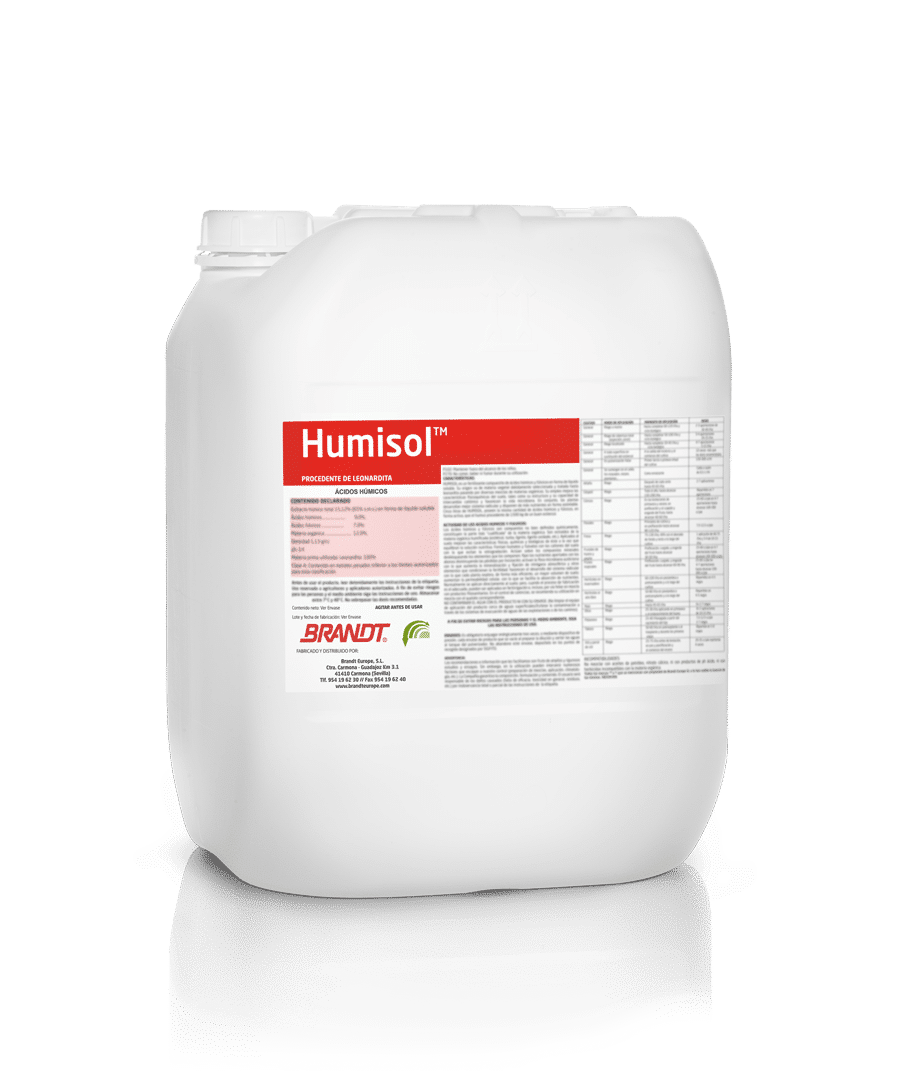This website uses cookies so that we can provide you with the best user experience possible. Cookie information is stored in your browser and performs functions such as recognising you when you return to our website and helping our team to understand which sections of the website you find most interesting and useful.
Humisol

Humisol is a humic amendment composed of humic and fulvic acids in the form of a soluble liquid. Its origin ranges from duly selected and treated vegetable matter to leonardite and various mixtures of organic matters.
Its use improves the physicochemical characteristics of the soil, such as its structure and cation exchange capacity and promotes microbial life.
- Advantages
- Crops
- Applications and use
- Composition
- Nutritional Composition
Advantages
Humisol is a humic amendment, composed of humic and fulvic acids in the form of soluble liquid, its origin derives from duly selected vegetable matter and treated to leonardite through various mixtures of organic materials. Its use improves the physicochemical characteristics of the soil, such as its structure and its cation exchange capacity and favors microbial life.
Overall, plants develop a better root system and have more nutrients available in assimilable form. There is the same amount of active humic and fulvic acids in five litres of HUMISOL as in humus from 1500 kg of good manure.
Crops
Applications and use
Humic and fulvic acids are chemically ill-defined compounds and constitute the most “qualified” part of organic matter.
They are extracted from humidified organic matter (manure, peat, lignite, oxidized lignite, etc.) and applied to the soil to improve its physical, chemical and biological characteristics while balancing the nutrient solution.
They form humates and fulvates with the cations of the soil, thus avoiding retrogradation.
They act on the mineral compounds by unlocking the elements that compose them, fix the nutrients provided with the fertilizers decreasing the losses by leaching, activate the native microbial flora increasing the mineralization and fixation of atmospheric nitrogen and other elements that condition fertility, favor the development of the root system and increase cell permeability facilitating the absorption of nutrients.
Normally they are applied directly to the soil, but when the manufacturing process is adequate they can be applied in fertigation and by foliar route in mixture with plant protection products.
It is recommended to use it mixed with the corresponding chelate, to control of deficiencies.
| CROP | MODE OF APPLICATION | APPLICATION PERIOD | DOSE |
|---|---|---|---|
| General | Irrigation blanket | Up to complete 60-120 l/ha and biological cycle | 2-3 doses of 30-40 l/ha |
| General | Irrigation of total coverage | Up to complete 50-100 L/ha and biological cycle | 3-4 doses of 20-25 l/ha |
| General | Irrigation localized | Up to complete 20-45 l/ha and biological cycle | 4-7 doses 5-15 l/ha |
| General | A full surface in place of manure | At the end of winter and at the beginning of the crop season | 10 time more than the recommended doses |
| General | Foliar spray | First third or first half of the crop | 150-300 cc/hl |
| General | The cuttings, paws, seedlings are immersed in the mixture. | As a rooting | Mixture at a rate of 0,5-1 l/hl |
| Alfalfa | Irrigation | After each cut of 45-65 l/ha | 2-7 applications |
| Grass | Irrigation | All year until reaching 150-200 l/ha | Divided into 7 contributions |
| Citrus | Irrigation | In spring and summer budding in pre-flowering and curdling and fattening of the fruit until reaching 40-60 l/ha | 25-60 cc/ft in 4-7 contributions until reaching 100-300 cc/ft |
| Floral | Irrigation | First growth stages and preflowering until reaching 80-120 l/ha | 7,5-12,5 cc/ft |
| Strawberry | Irrigation | 75-130 l/ha, 40% with the bottom fertilizer and rest throughout the crop | One dose of 40-75 l/ha & 3-4 de 10-15 l/ha |
| Fruit of bone and nugget | Irrigation | Preflowering, setting and fattening of the fruit until reaching 30-50 l/h | 25-60 cc/ft in 4-7 contributions until reaching 100-300 cc/ft |
| Tropical fruits | Irrigation | Preflowering, curdling and fattening of the fruit until reaching | 25-60 cc/ft in 4-7 contributions until reaching 100-300 cc/ft |
| Horticulture outdoor | Irrigation | 50-80 l/ha in pre-plant or pre-transplant and throughout the crio | Distributed in 4-5 irrigations |
| Corn | Irrigation | Until 45-65 l/ha | Distributed in 2-7 irrigations |
| Olive tree | Irrigation | 25-30 l/ha applied in strping and to bone hardening | 2 doses of 10-15 l/ha |
| Banana | Irrigation | 25-40 l/ha from the birth of the child | 7,5-12,5 cc/ft 2-7 irrigations |
| Tobacco | Irrigation | 50-60 l/ha pre-transplantation or transplantation and during the first old plants | Distributed in 5-6 irrigations |
| Vine and vineyard | Irrigation | before budding, in pre-post-flowering and at the beginning of the growing season | 20-35 cc/ft repeating 4 times |
| Horticulture in greenhouse | Irrigation | 60-100 l/ha in pre-seeding or pre-transplantation and throughout the crop | Distributed in 4-5 irrigations |
Composition
Total humic extract: 15.12 % (65 % s.m.s.) in the form of a soluble liquid
- Humic acids: 9.0 %
- Fulvic acids: 7.0 %
Organic matter: 12.0 %
Density: 1.13 g/cc
pH: 14
Raw material used: 100 % Leonardite Class A: heavy metal content below the limits authorised for this classification.

